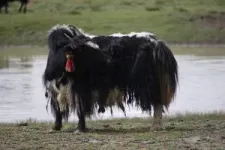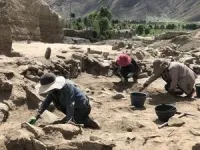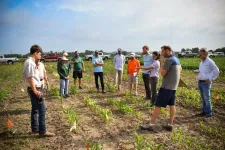(Press-News.org) The high-altitude hero of the Himalayas, yak are among the few large animals that can survive the extremely cold, harsh and oxygen-poor conditions of the Tibetan Plateau. In the mountainous regions of Asia, yak and yak-cattle hybrids serve as vital sources of meat, milk, transportation and fuel. However, little is known about their history: when or where yak were domesticated.
In a study published Dec. 13 in Science Advances, an international team of researchers that includes archaeologists at Washington University in St. Louis report archaeologically and genetically confirmed evidence for domestic yak, dating back 2,500 years, by far the oldest record.
The researchers zeroed in on this date using ancient DNA from a single male yak that lived alongside domestic cattle and yak-cattle hybrids in a settlement known as Bangga, a community in the southern Tibetan Plateau located at an elevation of approximately 3,750 meters (12,300 feet) above sea level.
“Many scholars have speculated that yak was first domesticated in the high-altitude regions of the Tibetan Plateau,” said Xinyi Liu, an associate professor of archaeology in Arts & Sciences at Washington University. “It was a well-informed speculation, but up to this point, there hasn’t been robust evidence for that,” Liu said. “This is the first evidence supported by both archaeology and ancient DNA.”
From unknown origins
Once widespread in the Tibetan Plateau, wild yak are now listed as “vulnerable” by the International Union for Conservation of Nature, with only an estimated 7,500 to 10,000 mature individuals left in the wild.
Domesticated yak, however, are prevalent across much of the world. An estimated 14 million to 15 million live in the highlands of Asia alone.
Scientists have previously traced the origins of other domestic bovine species found in Asia. This includes the taurine cattle found primarily in Europe and temperate areas of Asia; indicine cattle, or zebus, found primarily in India and tropical areas of Asia; and water buffalos in East and Southeast Asia. “Yak remains an open inquiry,” Liu said.
“Identifying domestic yak and yak-cattle hybrids at Bangga is not only essential to the understanding of the origin of this charismatic creature, the yak, but also informs us in general about animal domestication pathways, in which gene flow between related stocks is increasingly appreciated,” he said.
A transdisciplinary approach
Bangga is one of the earliest agro-pastoral settlements in the southern Tibetan Plateau and the only site in the region with abundant animal remains to have been systematically excavated in recent decades. This work at Bangga, led by Hongliang Lu from Sichuan University, has provided scientists with a glimpse of daily lives at extremely high elevations between 3,000 and 2,000 years ago, contributing excellent momentum around improving our knowledge about the ancient Himalayan region.
The excavations at Bangga also offer a rare opportunity to explore the history of early yak, cattle and their hybrids. For this study, Liu and his fellow archaeologists paired up with livestock geneticists. The team used ancient DNA sequencing as well as zooarchaeological analysis and radiocarbon measurements to help answer questions that could not be resolved with field analysis alone. “Our research at Bangga is a good example of the transdisciplinary and internationally collaborative nature of the 21st century archaeology,” Liu said.
Starting with more than 10,000 pieces of mammal bones collected at Bangga, Zhengwei Zhang, an alumnus of Washington University who is now a postdoctoral researcher at Sichuan University, identified and sorted out 193 specimens belonging to the genus Bos, a group that includes all domestic cattle, zebus and yak, as well as their wild progenitors, aurochs.
The researchers subsequently selected five well-preserved bones from these Bos samples to sequence for whole-genomic ancestry. The sequencing work was led by Ningbo Chen and Chuzhao Lei, two leading geneticists at Northwest A&F University who specialized in Bos domestication.
Genetic analysis revealed that only one of the ancient bones came from a yak, a male individual, while the other four bones were from female taurine cattle. Even figuring out that the cattle were taurine cattle was a surprise, Liu said, as Bangga is located close to the Himalayas and within the range of zebus and Indian aurochs, which were not found at Bangga. Instead, the cattle belonged to the taurine lineage that was introduced to the region from Anatolia via the silk route and northern Tibetan Plateau.
Additional analysis helped clarify that the bone from the male yak was truly a domestic variant, and not just a bone from a wild yak that hunters had killed and brought back to the settlement as food. The researchers also saw evidence for hybridization between the two species.
Bringing yak home
This new discovery of domesticated yak from 2,500 years ago fits into the larger story that is beginning to emerge about how humans adapted to living in a high-altitude environment on the Tibetan Plateau. For example, Liu and his colleagues have previously documented how people in this region grew barley as they faced a challenging environment.
“Bangga provided us with a unique window into lifeways at high elevations 3,000 to 2,000 years ago,” Liu said. “They cultivated barley in an intensive way, provisioned sheep with fodder and water and consumed milk. All these resources were introduced to the Tibetan Plateau from other world regions as part of prehistoric food globalization and had become part of the Tibetan legacy. Now we know they had domestic yak.”
This discovery of the genetically confirmed evidence of domestic yak does not yet solve all questions about yak domestication, nor does it necessarily represent the very beginning of that domestication process. However, it hints at what motivated herders to bring yak home.
Early herders in this region were likely faced with harsh conditions, where animals died out quickly because of prolonged winters and severe snow storms. One would need to be innovative, living in such conditions. A possible solution is intensive corralling, which would have allowed herders to provision their herds with agricultural by-products and water year-round. This strategy is attested by recent zooarchaeological and isotopic work led by Liu and Zhang.
The other solution would be to combine the environmental hardiness of yak with the productivity of cattle. “Dzomo (female hybrid) and dzo (male) are still the most common stocks in the Plateau even today for that reason. Cattle produce more milk and meat, but they are not as good at adapting to the high-altitude environment as yak,” Liu said. “Hybridization allows cattle to move high, and yak to move low at the same time they produce more milk.”
Study co-author Fiona Marshall, professor emerita of Washington University and a world-leading expert on animal domestication, said the study draws attention to the genetic continuity among domestic yak and taurine cattle on the Tibetan Plateau. In many regions of the world, early domesticated animals were replaced by later varieties. The genomic data suggests such faunal turnover did not happen on the Tibetan Plateau.
“This suggests a successful and long-lasting legacy of early Tibetan communities who were cosmopolitan in subsistence strategies and resilient and innovative in facing a challenging climate,” Liu said. “Bangga provides the best example of such a community.”
END
Earliest evidence for domestic yak found using both archaeology, ancient DNA
2023-12-13
ELSE PRESS RELEASES FROM THIS DATE:
Deep neural networks show promise as models of human hearing
2023-12-13
CAMBRIDGE, MA -- Computational models that mimic the structure and function of the human auditory system could help researchers design better hearing aids, cochlear implants, and brain-machine interfaces. A new study from MIT has found that modern computational models derived from machine learning are moving closer to this goal.
In the largest study yet of deep neural networks that have been trained to perform auditory tasks, the MIT team showed that most of these models generate internal representations ...
Researchers create stable hybrid laser by 3D printing micro-optics onto fibers
2023-12-13
WASHINGTON — For the first time, researchers have shown that 3D-printed polymer-based micro-optics can withstand the heat and power levels that occur inside a laser. The advance enables inexpensive compact and stable laser sources that would be useful in a variety of applications, including the lidar systems used for autonomous vehicles.
“We significantly reduced the size of a laser by using 3D printing to fabricate high-quality micro-optics directly on glass fibers used inside of lasers,” said research team leader Simon Angstenberger from the 4th Physics Institute at University of Stuttgart ...
Wistar scientists enhance cell-based therapy to destroy solid tumors
2023-12-13
PHILADELPHIA—(Dec. 13, 2023)—Wistar researchers successfully tested a simple intervention that could unlock greater anti-tumor power in therapies that use T cells — an approach known as “cell-based therapy,” which uses specially designed T cells to fight cancer. Led by Dr. Hildegund C.J. Ertl — a professor in The Wistar Institute’s Vaccine & Immunotherapy Center — the team has proven an exciting concept: that the common cholesterol drug fenofibrate can boost T cells’ ability to destroy human tumors, as described in their new paper, “Treatment ...
Trees are in trouble
2023-12-13
This holiday season brings surprising news about your Christmas tree. Scientists just discovered that globally, trees growing in wetter regions are more sensitive to drought. That means if your tree hails from a more humid clime, it’s likely been spoiled for generations.
Scientists have long debated whether arid conditions make trees more or less resilient to drought. It seems intuitive that trees living at their biological limits will be most vulnerable to climate change, since even just a little extra stress could tip them past the brink. On the other hand, these populations have adapted to a harsher setting, so they might be more capable of withstanding a drought.
According ...
New genetic vulnerability to herbicide found in nearly 50 sweet and field corn lines
2023-12-13
URBANA, Ill. — When a sweet corn breeder reached out in 2021 to report severe injury from the herbicide tolpyralate, Marty Williams hoped it was a fluke isolated to a single inbred line. But two years later, after methodical field, greenhouse, and genetic testing, his new Pest Management Science study not only confirms sensitivity to tolpyralate in 49 sweet corn and field corn lines, but also reveals a new genetic vulnerability that may affect corn more generally.
Tolpyralate is a relatively new ...
Charles Lee inducted as a fellow of The Korean Academy of Science and Technology
2023-12-13
The Korean Academy of Science and Technology (KAST), the highest institution of its kind in South Korea, announced Charles Lee, Ph.D., FACMG, as a newly inducted fellow of the Academy. This recognition is given to scientists and engineers who have been active in their field for more than 20 years and made significant contributions during that time.
Lee is the scientific director and professor at The Jackson Laboratory for Genomic Medicine, and is the Robert Alvine Family Endowed Chair. He was awarded the KAST honor in recognition of his extensive global contributions to human genomics research. Dr. Lee is one of 33 newly appointed fellows to the academy ...
Women may pay a "MOM PENALTY" when AI is used in hiring, new research from NYU Tandon School of Engineering suggests
2023-12-13
Maternity-related employment gaps may cause job candidates to be unfairly screened out of positions for which they are otherwise qualified, according to new research from NYU Tandon School of Engineering.
A research team led by Siddharth Garg, Institute Associate Professor of Electrical and Computer Engineering, examined bias in Large Language Models (LLMs) – advanced AI systems trained to understand and generate human language – when used in hiring processes.
The team will present its findings in a paper presented at NeurIPS ...
Study presents new pathway for electrochemically controlling ion selectivity
2023-12-13
A new study by researchers at the University of Illinois Urbana-Champaign advances fundamental knowledge about the role of solvation in ion binding and presents a new pathway for electrochemically controlling ion selectivity. The study was published in JACS Au.
The team, led by Chemical & Biomolecular Engineering professor Xiao Su and recently graduated Ph.D. student Raylin Chen, is building on their prior work exploring electrochemical separations of ions, which has revealed that a critical mechanism for binding ions is solvation.
Here, the researchers set out to control solvation of a polymer and use that to bind different ...
Poor diet quality during adolescence is linked to serious health risks
2023-12-13
Philadelphia, December 13, 2023 – Diet quality among adolescents in the United States is among the worst across all age groups, putting young people at risk for heart attack, stroke, and diabetes, among other cardiometabolic diseases later in life. The research brief shared in the Journal of Nutrition Education and Behavior, published by Elsevier, used the Healthy Eating Index-2015 and medical testing to assess a group of youth aged 10-16 years.
This study examined data from the Translational Investigation of Growth and Everyday Routine in Kids cohort. This study measured physical activity, sleep, and overall dietary guidelines for youth living in metropolitan areas ...
Stuart Parkin to receive American Physical Society’s highest award for contributions to spintronics and data storage
2023-12-13
The American Physical Society (APS) has awarded Stuart Parkin of the Max Planck Institute of Microstructure Physics the 2024 APS Medal for Exceptional Achievement in Research. Parkin will be recognized “for major discoveries in spintronics leading to a revolution in data storage and memory” at a ceremony during the APS Annual Leadership Meeting in January 2024.
“Stuart Parkin is a luminary whose incisive experiments and major discoveries in spintronics led to a revolution in data storage and memory,” said APS President-Elect Young-Kee Kim, who chaired the medal’s selection committee. “His indomitable ...







